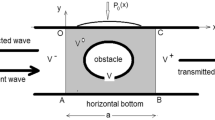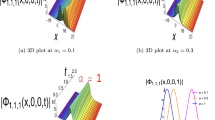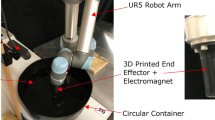Abstract
The ability to send a wave to fetch an object from a distance would find a broad range of applications. Quasi-standing Faraday waves on water create horizontal vortices1,2, yet it is not known whether propagating waves can generate large-scale flows—small-amplitude irrotational waves only push particles in the direction of propagation3,4,5. Here we show that when waves become three-dimensional as a result of the modulation instability, a floater can be forced to move towards the wave source. The mechanism for this is the generation of surface vortices by waves propagating away from vertically oscillating plungers. We introduce a new conceptual framework for understanding wave-driven flows, which enables us to engineer inward and outward surface jets, stationary vortices, and other complex flows. The results form a new basis for the remote manipulation of objects on fluid surfaces and for a better understanding of the motion of floaters in the ocean, the generation of wave-driven jets, and the formation of Lagrangian coherent structures.
This is a preview of subscription content, access via your institution
Access options
Subscribe to this journal
Receive 12 print issues and online access
$259.00 per year
only $21.58 per issue
Buy this article
- Purchase on SpringerLink
- Instant access to full article PDF
Prices may be subject to local taxes which are calculated during checkout




Similar content being viewed by others
References
Francois, N., Xia, H., Punzmann, H. & Shats, M. Inverse energy cascade and emergence of large coherent vortices in turbulence driven by Faraday waves. Phys. Rev. Lett. 110, 194501 (2013).
Francois, N., Xia, H., Punzmann, H., Ramsden, S. & Shats, M. Three-dimensional fluid motion in Faraday waves: Creation of vorticity and generation of two-dimensional turbulence. Phys. Rev. X 4, 021021 (2014).
Stokes, G. G. On the theory of oscillatory waves. Trans. Camb. Phil. Soc. 8, 441–455 (1847). Reprinted in Stokes, G. G. Mathematical and Physical Papers Vol. 1, 197–229 (Cambridge Univ. Press, 1880).
Falkovich, G. Fluid Mechanics: A Short Course for Physicists (Cambridge Univ. Press, 2011).
Constantin, A. On the deep water wave motion. J. Phys. A 34, 1405–1417 (2001).
Scales, J. A. & Snieder, R. What is a wave? Nature 401, 739–740 (1999).
Matioc, A-V. On particle trajectories in linear water waves. Nonlinear Anal. Real World Appl. 11, 4275–4284 (2010).
Longuet-Higgins, M. S. The trajectories of particles in steep, symmetric gravity waves. J. Fluid Mech. 94, 497–517 (1979).
Hogan, S. J. Particle trajectories in nonlinear capillary waves. J. Fluid Mech. 143, 243–252 (1984).
Benjamin, T. B. & Feir, J. E. The disintegration of wave trains on deep water. J. Fluid Mech. 27, 417–430 (1967).
Zakharov, V. E. Stability of periodic waves of finite amplitude on the surface of a deep fluid. J. Appl. Mech. Tech. Phys. 2, 190–194 (1968).
Saffman, P. G. & Yuen, H. C. A new type of three-dimensional deep-water waves of permanent form. J. Fluid Mech. 101, 797–808 (1980).
Meiron, D. I., Saffman, P. G. & Yuen, H. C. Calculation of steady three-dimensional deep-water waves. J . Fluid Mech. 124, 109–121 (1982).
Su, M-Y. Three-dimensional deep water waves. Part 1. Experimental measurements of skew and symmetric wave patterns. J. Fluid Mech. 124, 73–108 (1982).
Von Kameke, A., Huhn, F., Fernández-García, G., Muñuzuri, A. P. & Pérez-Muñuzuri, V. Double cascade turbulence and Richardson dispersion in a horizontal fluid flow induced by Faraday waves. Phys. Rev. Lett. 107, 074502 (2011).
Wright, W. B., Budakian, R., Pine, D. J. & Putterman, S. J. Imaging of intermittency in ripple-wave turbulence. Science 278, 1609–1612 (1997).
Xia, H., Shats, M. & Punzmann, H. Modulation instability and capillary wave turbulence. Europhys. Lett. 91, 14002 (2010).
Xia, H. & Shats, M. Propagating solitons generated by localized perturbations on the surface of deep water. Phys. Rev. E 85, 026313 (2012).
Sharp, D. H. An overview of Rayleigh–Taylor instability. Physica 12D, 3–18 (1984).
Haller, G. & Yuan, G. Lagrangian coherent structures and mixing in two-dimensional turbulence. Physica D 147, 352–370 (2000).
Peacock, T. & Haller, G. Lagrangian coherent structures: The hidden skeleton of fluid flows. Phys. Today 66(2), 41–47 (2013).
Crocker, J. C. & Grier, D. G. Methods of digital video microscopy for colloidal studies. J. Colloid Interf. Sci. 179, 298–310 (1996).
Shadden, S. C., Lejien, F. & Marsden, J. E. Definition and properties of Lagrangian coherent structures from finite-time Lyapunov exponents in two-dimensional aperiodic flows. Physica D 212, 271–304 (2005).
Acknowledgements
This work was supported by the Australian Research Council’s Discovery Projects funding scheme (DP110101525). H.X. would like to acknowledge the support of the Australian Research Council’s Discovery Early Career Research Award (DE120100364). The authors thank K. Szewc for developing the code for the finite-time Lyapunov exponent analysis used to generate Fig. 4f, and M. Gwynneth for his help with experimental set-up. N.F. acknowledges the help of S. Ramsden of the National Computational Infrastructure, Vizlab, ANU with visualization of 3D flows and trajectories using the Houdini animation software. The research of G.F. was supported by the Minerva Foundation and the Binational Science Foundation (BSF).
Author information
Authors and Affiliations
Contributions
H.P., N.F. and M.S. designed and performed the experiments; H.X., N.F., G.F. and H.P. analysed the data. M.S. and G.F. wrote the paper. All authors discussed and edited the manuscript.
Corresponding author
Ethics declarations
Competing interests
The authors declare no competing financial interests.
Supplementary information
Supplementary Information
Supplementary Information (PDF 1590 kb)
Supplementary Movie
Supplementary Movie 1 (MP4 20521 kb)
Supplementary Movie
Supplementary Movie 2 (MP4 7076 kb)
Supplementary Movie
Supplementary Movie 3 (MP4 9039 kb)
Supplementary Movie
Supplementary Movie 4 (MP4 7129 kb)
Supplementary Movie
Supplementary Movie 5 (MP4 2287 kb)
Rights and permissions
About this article
Cite this article
Punzmann, H., Francois, N., Xia, H. et al. Generation and reversal of surface flows by propagating waves. Nature Phys 10, 658–663 (2014). https://doi.org/10.1038/nphys3041
Received:
Accepted:
Published:
Issue date:
DOI: https://doi.org/10.1038/nphys3041
This article is cited by
-
Optimal free-surface pumping by an undulating carpet
Nature Communications (2023)
-
Recurrent graph optimal transport for learning 3D flow motion in particle tracking
Nature Machine Intelligence (2023)
-
Bidirectional wave-propelled capillary spinners
Communications Physics (2023)
-
Manipulation of free-floating objects using Faraday flows and deep reinforcement learning
Scientific Reports (2022)
-
Wave-based liquid-interface metamaterials
Nature Communications (2017)



